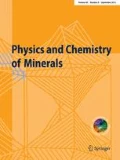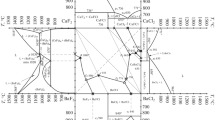Abstract
Generalized X-ray scattering factor model experimental electron density distributions and bond critical point, bcp, properties generated in recent studies for the earth materials stishovite, forsterite, fayalite and cuprite with high energy single crystal synchrotron X-ray diffraction data and those generated with high resolution diffraction data for coesite and senarmonite were found to be adequate and in relatively good agreement, ~5% on average, with those calculated with quantum chemical methods with relatively robust basis sets. High resolution low energy single crystal diffraction data, recorded for the molecular sieve AlPO4-15, were also found to yield model electron density distribution values at the bcp points for the AlO and PO bonded interactions that are in relatively good to moderately good agreement with the theoretical values, but the Laplacian values of the distribution at the points for the two bonded interactions were found to be in relatively poor agreement. In several cases, experimental bcp properties, generated with conventional low energy X-ray diffraction data for several rock forming minerals, were found overall to be in poorer agreement with the theoretical properties. The overall agreement between theoretical bcp properties generated with computational quantum methods and experimental properties generated with synchrotron high energy radiation not only provides a basis for using computational strategies for studying and modeling structures and their electron density distributions, but it also provides a basis for improving our understanding of the crystal chemistry and bonded interactions for earth materials. Theoretical bond critical point properties generated with computational quantum methods are believed to rival the accuracy of those determined experimentally. As such the calculations provide a powerful and efficient method for evaluating electron density distributions and the bonded interactions for a wide range of earth materials.






Similar content being viewed by others
References
Abramov Y, Volkov A, Coppens P (1999) On the evaluation of molecular dipole moments from multipole refinements of X-ray diffraction data. Chem Phys Lett 31:81–86
Aubert A, Porcher F, Souhassou M, Lecomte C (2003) Characterization of intra-framework and guest/host interactions in the AlPO4-15 molecular sieve by charge-density analysis. Acta Cryst B59:687–700
Bader RFW (1990) Atoms in molecules. Oxford Science Publications, Oxford
Bader RFW, MacDougall PJ (1985) Toward a theory of chemical reactivity based on charge density. JACS 107:6788–6795
Boisen MB, Gibbs GV, Bukowinski MST (1994) Framework silica structures generated using simulated annealing with a potential-energy function-based on an H6Si2O7 molecule. Phys Chem Miner 21:269–284
Boisen MB, Gibbs GV, O’Keeffe M, Bartelmehs KL (1999) A generation of framework structures for the tectosilicates using a molecular-based potential function and simulated annealing strategies. Micro Meso Mater 29:219–266
Brown ID and Shannon RD (1973) Empirical bond-strength bond-length curves for oxides. Acta Cryst A 29:266–281
Downs JW (1991) Electrostatic properties of minerals from X-ray diffraction data: a guide for accurate atomistic models In: Ganguly J (ed) Diffusion, atomic ordering, and mass transport, advances in physical geochemistry, vol 8. Springer, Berlin Heidelberg New York
Downs JW (1995) The electron density distribution of coesite. J Phys Chem 99:6849–6856
Downs JW, Swope RJ (1992) The Laplacian of the electron density and the electrostatic potential of danburite, CaB2Si2O8. J Phys Chem 96:4834–4840
Flensburg C, Larsen S, Stewart RF (1995) Experimental charge density study of methylammonium hydrogen succinate monohydrate: a salt with a very short O–H–O hydrogen bond. J Phys Chem 99:10130–10141
Gatti C (1997) TOPOND96 User’s Manual, CNR–CSRSRC, Milano, Italy, pp 1–15
Gibbs GV (1982) Molecules as models for bonding in silicates. Am Mineral 67:421–450
Gibbs GV, Boisen MB, Hill FC, Tamada O, Downs RT (1998) SiO and GeO bonded interactions as inferred from the bond critical point properties of electron density distributions. Phys Chem Miner 25:574–584
Gibbs GV, Boisen MB, Beverly LL, Rosso KM (2001) A computational quantum study of the bonded interactions in earth materials and structurally and chemically related molecules, Molecular modeling theory. In: Cygan RT, Kubicki JD (eds) Applications in the geosciences. Reviews in Mineralogy and Geochemistry, vol 42. Mineralogical Society of America, Washington DC, 345–382
Gibbs GV, Whitten EW, Spackman MA, Stimpfl M, Downs RT, Carducci MD (2003) An exploration of theoretical and experimental electron density distributions and SiO bonded interactions for the silica polymorph coesite. J Phys Chem B 2003:12996–13006
Gibbs GV, Rosso KM, Cox DF, Ross DF, Boisen MB (2003) A physical basis for Pauling’s definition of bond strength. Phys Chem Miner 30:317–320
Gibbs GV, Cox DF, Rosso KM, (2004) A connection between empirical bond strength and the localization of electron density at the bond critical points of the SiO bonds in silicates. J Phys Chem A 108:7643–7645
Ivanov YU, Belokoneva EL, Protas J, Hansen NK, Tsirelson VG (1998) Multipole analysis of the electron density in topaz using X-ray diffraction data. Acta Cryst B 54:774–781
Kirfel A, Gibbs GV (2000) Experimental electron density distributions and bonded interactions for fibrous zeolites natrolite, mesolite and scolecite and related materials. Phys Chem Miner 27:270–284
Kirfel A, Lippmann T (2002) Electron density distribution in fayalite, Fe2SiO4: a high energy synchrotron radiation study. http://www_hasylab.desy.de/science/annual_reports/2002_report/index.html
Kirfel A, Krane HG, Blaha P, Schwarz K, Lippmann T (2001) Electron-density in stishovite, SiO2: a new high-energy synchrotron-radiation study. Acta Cryst A 57:663–677
Koritsanszky TS, Coppens P (2001) Chemical applications of X-ray charge-density analysis. Chem Rev 101:1583–1627
Kraka E, Cremer D (1990) Chemical implications of local features on the electron density distribution, Theoretical models of chemical bonding. In: Maksic ZB (ed) Part 2: the concept of the chemical bond. Springer, Berlin Heidelberg New York, pp 453–538
Kuntzinger S, Ghermani NE, Dusausoy Y, Lecomte C (1998) Distribution and topology of the electron density in a aluminosilicate compound from high resolution X-ray diffraction data: the case of scolecite. Acta Cryst B 54:819–833
Lasaga AC, Gibbs GV (1990) Ab-initio quantum mechanical calculations of water-rock interactions: adsorption and hydrolysis reactions. Am J Sci 290:263–295
Leach AR (2001) Molecular modeling, principles and applications. Prentice Hall, New York, pp 1–744
Lippmann T, Schneider JR (2000) Topological analysis of cuprite, Cu2O, using high energy synchrotron radiation data. Acta Cryst A 56:575–584
Lippmann T, Blaha P, Anderson NH, Poulsen HF, Wolf T, Schneider JR, Schwarz KH (2003) Charge density analysis of YBa2Cu3O6.98: comparison of theoretical and experimental results. Acta Cryst A 59:437–451
Luaña V, Costales A, More–Sánchez P, Martin Pendás A (2003) Ions in crystals: the topology of the electron density in ionic materials. 4. The danburite (CaB2Si2O8) case and the occurrence of oxide–oxide bond paths in crystals. J Phys Chem B 107:4912–4921
Pauling L (1929) The principles determining the structure of complex ionic crystals. JACS 51:1010–1026
Pelmenschikov A, Strandh H, Petterson LGN, Leszcynski J (2000) Lattice resistance to hydrolysis of SiOSi bonds of silicate minerals: Ab initio calculations of a single water attack onto the (001) and (111) β–cristobalite surfaces. J Phys Chem B 104:5779–5783
Puig–Molina A, Alvarez–Larena A, Piniella JF, Howard ST, Baert F (1998) The electron distribution in the nonlinear optical material 2–amino–5–nitropyridium dihydrogen phosphate. Struct Chem 9:395–402
Saunders VR, Dovesi R, Roetti C, Causá M, Harrison NM Orlando R, Aprá E (1998) CRYSTAL98 User’s Manual, University of Torino, Torino, Italy, pp 1–170
Slouf M, Holy A, Petricek V, Cisarova I (2002) Charge density study of hydrogen ([2,4-diaminopyrimidin-1-io)methyl]phosphonate monohydrate. Acta Cryst B 58:519–529
Stewart RF (1969) Generalized X-ray scattering factors. J Chem Phys 51:4569–4577
Stewart RF (1976) Electron population analysis with rigid pseudoatoms. Acta Cryst A 32:565–574
R Volkov A, Coppens P (2001) Critical examination of the radial functions in the Hansen–Coppens multipole model through topological analysis of primary and refined theoretical densities. Acta Cryst A 57:395–405
Volkov A, Abramov Y, Coppens P, Gatti C (2000) On the origin of topological differences between experimental and theoretical crystal charge densities. Acta Cryst A 56:332–339
Whitten AE, Dittrich B, Spackman MA, Turner P, Brown TC (2004) Charge density analysis of two polymorphs of antimony(III) oxide. R Soc Chem Dalton Trans 102:23–29
Acknowledgments
The National Science Foundation and The U.S. Department of Energy are thanked for supporting this study in part with Grants EAR–9627458 (GVG, MB Boisen, Jr.), EAR–0229472 (NL Ross, GVG), DE-FG02-03ER15389 (JD Rimstidt, GVG) and DE–FG02–97ER14751 (DFC). This paper was written in large part when GVG was a National Science Foundation Visiting Scholar at the University of Arizona in 2004. Bob Downs, Charlie Prewitt, Marilena Stimpfl, Richard Thompson and Markus Oligero at that institution are thanked for making the visit a very worthwhile, pleasant and profitable experience.
Author information
Authors and Affiliations
Corresponding author
Additional information
Dedicated to Professor Robert F. Stewart of Carnegie Mellon University on his retirement for his brilliant and original work modeling electron density distributions.
Rights and permissions
About this article
Cite this article
Gibbs, G.V., Cox, D.F., Rosso, K.M. et al. Experimental and theoretical bond critical point properties for model electron density distributions for earth materials. Phys Chem Minerals 32, 114–125 (2005). https://doi.org/10.1007/s00269-005-0456-9
Received:
Accepted:
Published:
Issue Date:
DOI: https://doi.org/10.1007/s00269-005-0456-9




